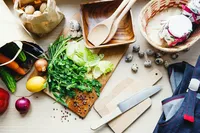Take a bite out of these scrappy recipes from Google chefs

There’s been an uptick in home-cooked meals in my life over the past couple of years. (Quarantine cooking, anyone?) As my cooking increased, so did the food scraps. And while using my trusty compost bin has kept most of my unused food from heading to the landfill, I’ve made it a goal to get more scrappy with my cooking to cut back on food waste.
Finding creative ways to reduce food waste is something that teams at Google have been thinking about for years — especially with its recent pledges to cut food waste in half for each Googler and send zero food waste to the landfill by 2025. If they can figure out how to work with suppliers, chefs and Googlers to reduce food waste across offices in 170 cities — surely they could help me do the same in my kitchen. So for Stop Food Waste Day, I chatted with the chef behind Google’s food program, Michael Kann, to hear what Google is doing to cut back on food waste and learn tricks the rest of us can adopt at home — including scrappy recipes straight from Google’s kitchens!
Before you joined Google as the Global Culinary Strategy & Development Lead, your career spanned everything from working as a chef and training chefs to feeding entire student bodies at universities and airline passengers at cruising altitude. How have you thought about food waste in all these roles?
Food waste is a top focus for chefs — whether it’s because of the cost of goods or the environmental impact — and it’s something we take personally. There are techniques that culinary professionals use to reduce food waste no matter how many people they’re cooking for — everything from using as much of the product as possible during prep to coming up with inventive recipes that make the most of ingredients.
At Google, my focus is on infusing these strategies across our cafes and suppliers. My team and I also look at how technology — like Leanpath which helps chefs track what food is going to waste — can help our cafes reduce food waste.
For the home chefs, what tricks and tips can minimize our personal food waste?
Careful planning, prep and organization are the most important steps in reducing waste at home.
Plan out what you are making for the week so you buy only the ingredients you need, and leave days open for leftovers. When it comes to prepping the food, consider how you can do so in a way that maximizes how much of the piece of produce you use. For example, people often cut the entire top off a tomato instead of coring it. If you core it first, you can use the slices for dishes like sandwiches, and the rounded ends can be diced and made into something like salsa.
Get organized with how you store leftovers and new groceries. The first-in, first-out (FIFO) organization system used in most professional kitchens works great at home. First, label or mentally keep track of leftovers and find the expiration date on groceries. Then keep the items that expire first in front, so you’re more likely to grab them and use them.
Now for the tasty part, what are your favorite recipes that feature commonly scrapped foods as ingredients?
Stocks, stocks, and more stocks. Making vegetable stock is a great use of what might otherwise be wasted — like carrots nubs or celery ends. But never use the skins of carrots or onions — it will make your stock bitter.
Broccoli florets are a highly desired vegetable — when I worked at a university it was the most eaten vegetable. But it’s important to plan the menu for the rest of the plant that’s often forgotten: the broccoli stalk. A broccoli soup is a go-to standard, but I also enjoy a great broccoli slaw. This Broccoli Stalk Salad recipe — from Dana Gunders, a national expert and strategic advisor for food waste reduction and author of Waste Free Kitchen Handbook — makes a tasty slaw simply from shredding broccoli stems and carrots. You can also check out her Talks@Google for a kitchen demo and more tips.
On the more creative side, you can pickle things you'd typically toss — like cantaloupe rinds. Just cut them into strips, pickle them, and add them as a fun accouterment to any meal.
Vegetable Stock
Makes 1 gallon
Uses up: Leek tops, celery ends, herb stems, onion bits, ends of zucchini or summer squash
Using vegetable trims in stock is a great way to capture every last bit of goodness from the food you’ve brought into your home. With that said, some things make a stock bitter, sulfuric or just down right bad. So while I recommend using the trim of vegetables, it’s not the same as just throwing everything in the pot.
Key things to think about
- You can freeze your trimmings to build up enough for a batch of stock. Freezing makes the texture mushy, but traps the nutrients which is what you really want.
- Avoid peels, especially onions and carrots. The peel is a protective barrier for the plant and is often bitter. Adding these to your stock will intensify the bitterness.
- Be careful with cruciferous vegetables (broccoli, cauliflower, cabbages, etc.). Adding some may give a flavor you desire, but too many can be overwhelming. Note that the longer these items cook, the more sulfur taste and smell. This is why boiled cabbage smells so bad the longer you cook it, so brief is key here.
- If an item is not viable to be eaten, don’t add it to your stock. For example, if an onion has a rotten side, cut out the rot and use the good parts. Watch your refrigerator and use the items before they turn.
- Wash the dirt off of everything before adding to the pot. We want flavor, not grit.
- The broth will last 5-7 days refrigerated or can be frozen.
Ingredients
3-4 pounds of mixed vegetables using the guidelines above
1 medium onion
2 carrots (peeled)
2 ribs of celery
3 bay leaves
5 peppercorn (more or less depending on your preference)
Herb stems
1 gallon cold water
Preparation
- Put everything in a pot
- Start from cold, then bring to a simmer (to remain at or just below the boiling point, usually forming tiny bubbles with a low, murmuring sound)
- Simmer for 45 minutes
- Strain through a sieve
- Chill strained broth
Broccoli Stalk Salad
Makes 5 servings
Uses up: Broccoli stalks, avocados, carrots
For many of us, the stalks are the evil half of broccoli. We toss them away in favor of their soft-headed florets. But this salad depends on the stalks for extra crunch, so save them! Adding in creamy avocados and carrots makes the dish creamy and sweet. Make a chopped salad or grate all but the avocado for more of a slaw effect.
Ingredients
For the dressing
4 tablespoons olive oil
3 tablespoons red wine vinegar
2 teaspoons honey
1/4 teaspoon kosher salt
Pepper to taste
For the salad
3 or 4 large broccoli stalks (not the florets!), peeled and cut into thin medallions
½ to 1 avocado, cut into 1/8-inch slices
1 carrot, peeled into long, thin strips
1/4 cup red onion, thinly sliced
1 tablespoon fresh basil or cilantro as garnish (optional)
Preparation
- In a small bowl, combine the olive oil, vinegar, honey, salt and pepper
- In a medium bowl, combine salad ingredients
- Pour the dressing over the vegetables
- Let sit for 30 minutes before eating, allowing the broccoli to soften
- Serve at room temperature with a few extra leaves of basil or cilantro scattered on top
Quick Pickled Cantaloupe Rinds
Makes 3 quarts
Uses up: Cantaloupe rinds
Pickling is an age-old process that helps make harder to eat items more consumable. Melon rinds offer a terrific texture when pickled and help make something alluring out of what would otherwise be tossed into the compost.
Key things to think about
- Wash the melon before trimming.
- Do not use any part of the rind that has soft spots.
- Add dried peppers to spice it up, and play with the spices to find the balance you prefer.
- Use quart mason jars, while this will not be truly “canned” there will be temperature states that need robust strength.
- Use the wide mouth jars for ease of filling and emptying.
- The rinds will last for 2-3 weeks.
Ingredients
The rind from 1 small cantaloupe, thinly sliced into 1-inch strips that fit vertically into a mason jar
For the pickling liquid
2 cups white vinegar (or apple cider vinegar)
2 cups water
2 cups sugar
1 thumb ginger, sliced thin
5 each black peppercorns
1 pinch red pepper flakes (more or less based on preference)
5-6 each allspice (whole)
Preparation
- Tightly pack cantaloupe strips into mason jars
- Bring pickling liquid to a boil, reduce to a simmer until sugar has dissolved
- Pour directly into jars with cantaloupe rinds, be sure that the mason jars are at room temperature or even slightly warm (if they are cold they may crack)
- Tightly cover with lids and allow to cool on the counter for 1 hour
- Place in refrigerator







